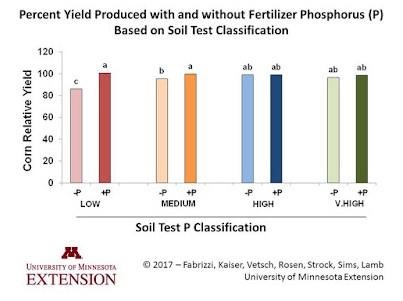By Karina Fabrizzi
When it comes to phosphorus management, there are two schools of thought: 1) the sufficiency approach, which is designed to maximize economic return for each dollar of P fertilizer applied; and 2) the build and maintain approach, which seeks to mitigate risk by keeping soil test P at a level that minimizes the potential for yield loss. In 2011, University of Minnesota, with funding provided by the Agricultural Fertilizer Research and Education Council (AFREC), set out to test these phosphorus management strategies in long-term replicated field experiments.
Six experiments were established across Minnesota in Olmsted, Polk, Redwood, Sherburne, Stevens and Waseca counties representing various soil types with differing parent materials. In Phase I, researchers applied 0, 30-40, 50-70 and 100-120 lbs P205 per acre in each of four years (2011-2014) to develop four categories of soil test P, classified as low, medium, high and very high as defined for Minnesota.
In Phase II, researchers examined maximum corn yield potential of the four soil test P classes after fertilization with P at 150% of the current suggested rates for corn in Minnesota. Across sites, corn grain yield responded to applied fertilizer P in the low and medium STP classes only. There was no grain yield response to applied P on high or very high STP classes. Additionally, there was no difference among the STP classes in maximum grain yield. These results revealed no risk of yield loss with the sufficiency approach using sufficient applications of fertilizer P based on soil test P, even on Low testing soils, level s compared to a building and maintaining high testing P soils.

“Maintaining high soil test values will ensure you have maximum yield potential,” said Dan Kaiser, Extension soil scientist. “But the likelihood of a yield increase to cover the cost of fertilizer is low and the best option for those with very high soil tests would be to not apply exact removal and allow the soil to supply some of the needed nutrients and focus fertilizer inputs where there will be a positive return on investment.”
Tips for phosphorus management:
- Use the soil test as a tool to gauge the risk of nutrient deficiencies in the soil. Know where the soil needs nutrients so you can put the fertilizer where it’s needed.
- Trust that the soil test will provide accurate information on where your best chance will be for a return on investment.
- Once you reach an optimum level, it doesn’t pay to be overly aggressive with fertilizer P management. Focus on other management investments what will bring a better return on investment.